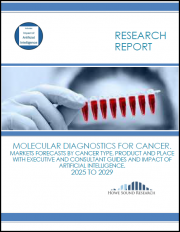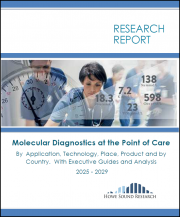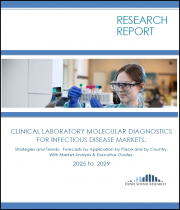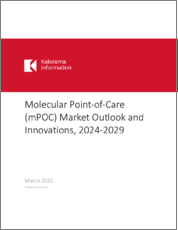
|
시장보고서
상품코드
1623507
세계의 분자진단 시장 규모 : 제품별, 용도별, 기술별, 지역별, 범위 및 예측Global Molecular Diagnostics Market Size By Product, By Application, By Technology, By Geographic Scope And Forecast |
||||||
분자진단 시장 규모와 예측
분자진단 시장 규모는 2024년에 190억 8,000만 달러로 평가되며, 2031년에는 332억 8,000만 달러에 달할 것으로 예측되며, 2024-2031년의 CAGR은 7.20%로 성장합니다. 분자진단학은 분자생물학을 이용해 질병을 연구하는 분야입니다. 세포와 체액내 유전물질(DNA, RNA)과 단백질을 조사했습니다. 이 연구 작업은 질병을 진단하고, 위험 요인을 파악하며, 맞춤형 치료 요법을 개발하는 데 도움이 됩니다. 이는 의료를 획일적인 접근 방식에서 보다 구체적이고 개별화된 전략으로 전환할 수 있는 획기적인 수단입니다. 분자진단은 의료를 변화시킬 수 있는 다양한 용도를 가지고 있습니다. 특정 바이러스 마커를 식별함으로써 COVID-19와 같은 감염성 질환을 진단하는 데 탁월합니다. 감염성 질환뿐만 아니라 많은 암과 관련된 유전자 변화를 감지할 수 있으며, 조기 발견과 표적 치료를 가능하게 합니다. 또한 이 기술은 특정 질병에 대한 감수성 및 치료에 대한 신체 반응을 판단하여 맞춤형 치료의 길을 열어줄 수 있습니다.
최근 수년간 다양한 신기술이 시장에 출시되고 있습니다. 샷건 메타유전체 차세대 염기서열 분석기는 환자의 샘플에 포함된 모든 알려진 미생물을 검출하는 종합적인 유전체 기반 진단 방법입니다. 각 샘플은 박테리아, 바이러스, 기생충, 곰팡이 등 약 40,000개의 미생물을 검사하며, MSI 분석 시스템은 우성 유전성 악성 종양인 린치 증후군과 관련된 미세 위성 불안정성(MSI)을 검출합니다. 분자진단 분야에서는 시료 준비 기술이 발전하고 있습니다.
세계 분자진단 시장 역학
세계 분자진단 시장을 형성하는 주요 시장 역학
주요 시장 성장 촉진요인
기술의 진보 :
기술의 발전: PCR, NGS, 디지털 PCR 등 분자진단 기술의 지속적인 혁신은 검사 정확도, 효율성, 확장성을 향상시켜 시장 확대를 촉진하고 있습니다. 이러한 발전은 혁신적인 진단 분석법 개발을 가능하게 하고, 분자진단의 적용 범위를 다양한 질병과 상황으로 확대할 수 있게 합니다.
만성질환 및 감염성 질환의 유행 증가:
암, 심혈관 질환, 당뇨병과 같은 만성질환 및 감염성 질환의 발달로 분자진단에 대한 수요가 증가하고 있습니다. 이러한 검사는 질병을 신속하고 정확하게 진단하고 조기 개입, 개인 맞춤형 치료 및 질병 관리를 가능하게 하여 세계 시장 성장을 주도하고 있습니다.
맞춤형 의료에 대한 수요 증가:
유전체학 및 정밀의료 접근법의 발전에 힘입어 맞춤형 의료의 발전은 분자진단의 사용을 가속화하고 있습니다. 이러한 검사는 개인의 유전적 체질, 질병 위험 및 치료 반응에 대한 정보를 제공하여 임상의가 환자에게 가장 효과적인 치료법을 찾아내는 데 도움을 줍니다. 개인 맞춤형 치료 기술에 대한 관심이 높아지면서 의료 서비스 제공에 있으며, 분자진단의 중요성이 더욱 부각되고 있습니다.
의료비 지출과 인식 증가:
의료비 지출 증가와 질병 조기 발견 및 예방 의학의 이점에 대한 지식이 증가하면서 분자진단의 채택이 증가하고 있습니다. 정부, 의료 기관, 환자 모두 의료 성과를 높이고 질병 부담을 줄이기 위해 새로운 진단 기술에 투자하고 있습니다. 의료 인프라에 대한 인식과 투자 증가는 전 세계에서 분자진단 검사에 대한 접근성을 높이고 시장 확대의 원동력이 되고 있습니다.
주요 과제
규제상의 장애물 :
분자진단 검사에 대한 엄격한 규제 장벽을 극복하고 허가를 받는 것은 어렵고 시간이 많이 걸립니다. 규제기관은 종종 엄격한 기준으로 검사의 안전성, 유효성 및 임상적 타당성을 심사하므로 시장 진입이 지연되고 제조업체의 컴플라이언스 비용이 증가합니다.
높은 실행 비용 :
분자진단 장비 및 기술 구매 및 유지에 드는 높은 비용은 산업 확장의 장벽이 되고 있습니다. 또한 이러한 첨단 시스템을 운영하기 위해서는 전문 인력이 필요하므로 전체 비용이 상승하고, 특히 자원이 제한된 환경에서는 접근성과 수용성이 제한됩니다.
기존의 검사 방법의 방해:
배양 기반 기술 및 면역측정법과 같은 전통적인 진단 방법은 친숙함, 비용 효율성 또는 인프라 제약 등의 이유로 여전히 분자진단 방법보다 선호될 수 있습니다. 기존 검사법에서 분자 검사법으로 전환하는 것에 대한 반대를 극복하는 것은 시장 침투와 광범위한 수용을 위한 과제입니다.
데이터 분석 및 표준화 :
진단 검사에서 얻은 복잡한 분자 데이터를 해석하고 검사기관 간 일관성을 확보하는 것은 어렵습니다. 검사 방법, 데이터 분석 기술, 보고 기준의 편차는 결과의 편차로 이어져 분자진단의 신뢰성과 비교 가능성을 떨어뜨립니다. 이 문제를 극복하기 위해서는 탄탄한 품질관리 시스템과 일관된 규범을 확립하는 것이 중요합니다.
주요 동향
Point-of-care 검사 실시:
환자의 병상이나 지역 환경에서 신속한 진단과 치료 방침을 결정할 수 있는 현장 분자 검사에 대한 관심이 높아지고 있습니다. 이러한 변화는 특히 원격지나 자원이 부족한 지역에서 시간을 단축하고 의료 서비스의 효율성을 향상시킬 수 있습니다.
AI와 빅데이터 분석의 통합:
AI와 빅데이터 분석이 분자진단 절차에 통합되어 복잡한 분자 데이터를 보다 정확하게 해석하고 바이오마커를 식별할 수 있게 되었습니다. 이러한 기술은 진단 정확도를 높이고, 데이터 분석 속도를 높이며, 맞춤 치료 계획을 가능하게 합니다.
액체생검 응용 확대:
혈액 샘플에서 순환 종양 DNA 및 기타 바이오마커를 분석하는 액체생검은 분자진단 분야에서 인기를 끌고 있습니다. 이 비침습적 접근법은 암을 조기에 발견하고, 치료 효과를 추적하고, 최소 잔존 병변을 발견할 수 있으며, 암 진단에 널리 사용되고 있습니다.
디지털 PCR 및 NGS 기술의 출현:
디지털 PCR과 차세대 염기서열 분석(NGS) 기술은 기존 접근법보다 민감도, 분해능, 처리량이 향상되어 분자진단에 점점 더 많이 사용되고 있습니다. 이러한 발전은 광범위한 유전자 분석, 희귀 돌연변이 검출, 질병 원인에 대한 더 깊은 지식을 가능하게 하여 분자진단의 미래에 영향을 미치고 있습니다.
목차
제1장 서론
- 시장 정의
- 시장 세분화
- 조사 방법
제2장 개요
- 주요 조사 결과
- 시장 개요
- 시장 하이라이트
제3장 시장 개요
- 시장 규모와 성장 가능성
- 시장 동향
- 시장 성장 촉진요인
- 시장 성장 억제요인
- 시장 기회
- Porter's Five Forces 분석
제4장 분자진단 시장 : 제품별
- 기기
- 시약·소모품
제5장 분자진단 시장 : 용도별
- 감염증
- 종양학
- 유전자 검사
- 혈액 스크리닝
제6장 분자진단 시장 : 기술별
- 중합효소 연쇄 반응(PCR)
- 차세대 시퀀싱(NGS)
- In Situ 하이브리다이제이션(ISH)
- 마이크로어레이
- 질량분석(MS)
제7장 지역 분석
- 북미
- 미국
- 캐나다
- 멕시코
- 유럽
- 영국
- 독일
- 프랑스
- 이탈리아
- 아시아태평양
- 중국
- 일본
- 인도
- 호주
- 라틴아메리카
- 브라질
- 아르헨티나
- 칠레
- 중동 및 아프리카
- 남아프리카공화국
- 사우디아라비아
- 아랍에미리트
제8장 시장 역학
- 시장 성장 촉진요인
- 시장 성장 억제요인
- 시장 기회
- 시장에 대한 COVID-19의 영향
제9장 경쟁 구도
- 주요 기업
- 시장 점유율 분석
제10장 기업 개요
- Abbott Laboratories
- Roche Diagnostics
- Thermo Fisher Scientific
- Bio-Rad Laboratories
- QIAGEN
- Siemens Healthineers
- Becton
- Dickinson and Company(BD)
- Hologic, Inc.
- Danaher Corporation
- Agilent Technologies
제11장 시장 전망과 기회
- 신규 기술
- 향후 시장 동향
- 투자 기회
제12장 부록
- 약어 리스트
- 전시와 참고 문헌
Molecular Diagnostics Market Size And Forecast
Molecular Diagnostics Market size was valued at USD 19.08 Billion in 2024 and is projected to reach USD 33.28 Billion by 2031 , growing at a CAGR of 7.20% from 2024 to 2031. Molecular diagnostics is a field that uses molecular biology to study diseases. It investigates genetic material (DNA, RNA) and proteins in cells or fluids. This investigative work aids in disease diagnosis, risk factor identification, and even personalized treatment regimens. It's a game-changing instrument that is moving medicine away from a one-size-fits-all approach and toward a more specific and tailored strategy. Molecular diagnostics has a diverse set of applications that are transforming medicine. It excels at diagnosing infectious disorders like COVID-19 by identifying specific viral markers. Beyond infection, it can detect genetic changes associated with many cancers, allowing for early detection and targeted treatments. Furthermore, this technology can determine a person's susceptibility to particular diseases or how their body will react to treatments, paving the path for tailored therapy.
In recent years, various new technologies have been introduced to the market. Shotgun metagenomic next-generation sequencing is a comprehensive genomics-based diagnostic that detects all known microorganisms in a patient's sample. Each sample is examined for around 40,000 microorganisms, which include bacteria, viruses, parasites, and fungus. The MSI Analysis System detects microsatellite instability (MSI), which is associated with Lynch Syndrome, a dominant hereditary malignancy. Sample preparation techniques have advanced in the field of molecular diagnostics.
Global Molecular Diagnostics Market Dynamics
The key market dynamics that are shaping the global molecular diagnostics market include:
Key Market Drivers:
Advancements in Technology:
Continuous breakthroughs in molecular diagnostic technologies, including as PCR, NGS, and digital PCR, propel market expansion by boosting test accuracy, efficiency, and scalability. These advancements allow for the development of innovative diagnostic assays and broaden the application range of molecular diagnostics to a variety of diseases and situations.
Increased prevalence of chronic and infectious diseases:
The growing prevalence of chronic diseases such as cancer, cardiovascular disease, and diabetes, as well as developing infectious diseases, is driving the demand for molecular diagnostics. These tests diagnose diseases quickly and accurately, allowing for early intervention, individualized therapy, and disease management, driving global market growth.
Increasing Demand for Personalized Medicine:
The trend to customized medicine, fueled by advances in genomics and precision medicine approaches, accelerates the use of molecular diagnostics. These tests provide information about individuals' genetic makeup, disease risk, and treatment response, assisting clinicians in identifying the most effective therapy for patients. The increased emphasis on personalized treatment techniques highlights the importance of molecular diagnostics in healthcare delivery.
Increasing Healthcare Spending and Awareness:
Rising healthcare spending, combined with growing knowledge of the benefits of early disease identification and preventive care, is driving the adoption of molecular diagnostics. Governments, healthcare organizations, and patients are all investing in new diagnostic technology to enhance healthcare outcomes and lower illness burdens. Growing awareness and investment in healthcare infrastructure drives market expansion by increasing access to molecular diagnostic testing worldwide.
Key Challenges:
Regulatory hurdles:
Navigating rigorous regulatory hurdles and securing permission for molecular diagnostic tests can be difficult and time-consuming. Regulatory bodies frequently use severe criteria to examine the safety, effectiveness, and clinical validity of these tests, causing delays in market entrance and increasing compliance costs for producers.
High Implementation Costs:
The high cost of purchasing and maintaining molecular diagnostic equipment and technologies is a barrier to industry expansion. Furthermore, the necessity for specialized staff to operate these advanced systems raises the overall cost, restricting accessibility and acceptance, particularly in resource-constrained environments.
Interference from Traditional Testing Methods:
Traditional diagnostic procedures, such as culture-based techniques or immunoassays, may still be favored over molecular diagnostics for reasons of familiarity, cost-effectiveness, or infrastructural restrictions. Overcoming opposition to switching from conventional to molecular testing poses a challenge to market penetration and widespread acceptance.
Data Interpretation and Standardization:
Interpreting complicated molecular data produced by diagnostic testing and ensuring consistency among laboratories can be difficult. Variability in testing methodologies, data analysis techniques, and reporting standards can lead to variations in results, reducing the reliability and comparability of molecular diagnostics. To overcome this issue, it is critical to establish strong quality control systems and consistent norms.
Key Trends:
Implementation of Point-of-Care Testing:
There is a growing trend toward point-of-care molecular testing, which allows for rapid diagnosis and treatment decisions at the patient's bedside or in community settings. This change shortens turnaround times and improves healthcare efficiency, particularly in distant or resource-limited places.
Integration of AI and Big Data Analytics:
AI and big data analytics are increasingly being integrated into molecular diagnostic procedures, enabling for more accurate interpretation of complex molecular data and biomarker identification. These technologies improve diagnosis accuracy, speed data analysis, and enable individualized treatment plans.
Expansion of Liquid Biopsy Applications:
Liquid biopsy, which analyzes circulating tumor DNA or other biomarkers in blood samples, is gaining popularity in molecular diagnostics. This non-invasive approach allows for early cancer identification, treatment response tracking, and minimal residual disease detection, which is pushing its acceptance in oncology diagnostics.
Emergence of Digital PCR and NGS technologies:
Digital PCR and next-generation sequencing (NGS) technologies are increasingly being used in molecular diagnostics, as they provide improved sensitivity, resolution, and throughput than previous approaches. These developments allow for extensive genetic analysis, the detection of rare mutations, and a better knowledge of disease causes, influencing the future of molecular diagnostics.
What's inside a VMR industry report?
Our reports include actionable data and forward-looking analysis that help you craft pitches, create business plans, build presentations and write proposals.
Global Molecular Diagnostics Market Regional Analysis
Here is a more detailed regional analysis of the global molecular diagnostics market:
North America:
Several significant reasons contribute to North America's dominance in the Molecular Diagnostics market. For starters, the region has modern healthcare infrastructure and facilities, which makes molecular diagnostic technology more widely available. This infrastructure facilitates efficient testing processes and provides prompt and accurate diagnosis, which contributes to North America's market leadership.
North America is home to a variety of major pharmaceutical and biotechnology companies that make significant investments in research and development. These investments spur innovation in molecular diagnostics, resulting in the creation of new testing procedures and diagnostic tools. Continuous technological developments strengthen North America's position as a global leader in molecular diagnostics.
In North America, strong regulatory standards and guidelines ensure that molecular diagnostic products are of high quality and safe. The strict regulatory system gives healthcare professionals and patients trust in the reliability and precision of diagnostic tests, promoting wider usage. This regulatory environment promotes a favorable market environment, attracting investments and driving market growth in North America.
The prevalence of chronic diseases and infectious outbreaks in North America emphasizes the role of molecular diagnostics in disease management and surveillance. The region's high healthcare expenditures and emphasis on precision medicine fuel demand for innovative diagnostic solutions. As a result, North America remains at the forefront of the Molecular Diagnostics Market, dominating innovation, acceptance, and market share.
Asia Pacific:
Healthcare expenditure in the Asia Pacific region is rapidly increasing, owing to rising incomes, growing middle-class populations, and improved healthcare infrastructure. This increasing spending provides better access to new diagnostic technologies, such as molecular diagnostics, resulting in a boom in demand for these tests throughout the region.
The Asia Pacific region is seeing a huge increase in the prevalence of chronic diseases such as cancer, cardiovascular disease, and diabetes, as well as new infectious diseases. Molecular diagnostics provide reliable and quick detection of various disorders, which drives their use in clinical settings. As the region's disease burden increases, so does the demand for molecular diagnostics.
Government activities aiming at improving healthcare access, illness surveillance, and preventative healthcare measures are pushing molecular diagnostics usage across Asia Pacific. Healthcare reforms and regulations that encourage the development and implementation of sophisticated diagnostic technologies drive market growth, creating a favorable environment for investment and innovation.
The growing awareness among healthcare professionals and patients about the benefits of personalized and precision medicine is pushing the adoption of molecular diagnostics in Asia Pacific. With an emphasis on personalized treatment approaches based on genetic profiles and illness characteristics, molecular diagnostics is critical in guiding medication selection and improving patient outcomes.
Global Molecular Diagnostics Market Segmentation Analysis
The Global Molecular Diagnostics Market is Segmented on the basis of Product, Application, Technology, And Geography.
Molecular Diagnostics Market, By Product
- Instruments
- Reagents & Consumables
Based on Product, the market is bifurcated into Instruments and Reagents & Consumables. Reagents and consumables dominate the Molecular Diagnostics industry, outperforming devices. Two major elements contribute to this supremacy. For starters, unlike devices with lengthy lifespans, reagents such as test kits and enzymes are utilized and must be replaced on a regular basis to perform diagnostic tests. Second, the segment offers a broader range of test kits for a number of applications, including infectious disease testing and genetic analysis, as opposed to the more limited instrument category. However, the tide may be turning. Advancements in equipment, such as next-generation sequencing platforms, and rising need for automation may push their market share higher in the future.
Molecular Diagnostics Market, By Technology
- Polymerase Chain Reaction (PCR)
- Next-Generation Sequencing (NGS)
- In Situ Hybridization (ISH)
- Microarrays
- Mass Spectrometry (MS)
Based on Technology, the market is bifurcated into Polymerase Chain Reaction (PCR), Next-Generation Sequencing (NGS), In Situ Hybridization (ISH), Microarrays, and Mass Spectrometry (MS). The Polymerase Chain Reaction (PCR) segment dominates the Molecular Diagnostics Market because to its well-established technology, high sensitivity and specificity, and versatility across a wide range of diagnostic applications. PCR's capacity to accurately amplify tiny DNA or RNA samples makes it essential for detecting infectious illnesses, genetic abnormalities, and cancer. Continuous advancements, such as real-time and digital PCR, have improved its efficiency and accuracy, firmly establishing its market leadership.
Molecular Diagnostics Market, By Application
- Infectious Diseases
- Oncology
- Genetic Testing
- Blood Screening
Based on Application, the market is segmented into Infectious Diseases, Oncology, Genetic Testing, and Blood Screening. The Infectious Diseases segment dominates the Molecular Diagnostics Market due to the substantial need for speedy and accurate diagnostic tests that can detect a wide spectrum of pathogens. The worldwide spread of infectious diseases, particularly new and re-emerging infections, highlights the need for reliable diagnostic treatments. Molecular diagnostics have excellent sensitivity and specificity, making them critical for early detection, treatment, and outbreak control. Furthermore, continued advances in molecular technology and an increased emphasis on infectious disease control contribute to this segment's dominant position.
Molecular Diagnostics Market, By Geography
- North America
- Europe
- Asia Pacific
- Rest of the World
- On the basis of regional analysis, the Global Molecular Diagnostics Market is classified into North America, Europe, Asia Pacific, and the Rest of the world. North America leads the Global Molecular Diagnostics Market due to its advanced healthcare infrastructure, significant investment in R&D, and widespread use of cutting-edge technologies. The region benefits from the existence of top molecular diagnostics companies, as well as a strong regulatory framework that allows innovative diagnostic tests to be approved and commercialized quickly. Furthermore, the growing prevalence of chronic and infectious diseases, combined with rising healthcare costs, pushes demand for molecular diagnostics.
Key Players
- The "Global Molecular Diagnostics Market" study report will provide valuable insight with an emphasis on the global market. The major players in the market are
- Abbott Laboratories, Roche Diagnostics, Thermo Fisher Scientific, Bio-Rad Laboratories, QIAGEN, Siemens Healthineers, Becton, Dickinson and Company (BD), Hologic, Inc., Danaher Corporation, and Agilent Technologies.
- are all prominent players in the healthcare and diagnostics industry. The competitive landscape section also includes key development strategies, market share, and market ranking analysis of the above-mentioned players globally.
Our market analysis also entails a section solely dedicated to such major players wherein our analysts provide an insight into the financial statements of all the major players, along with product benchmarking and SWOT analysis. The competitive landscape section also includes key development strategies, market share, and market ranking analysis of the above-mentioned players globally.
- Molecular Diagnostics Market Recent Developments
- In February 2023, Thermo Fisher Scientific Inc. (US) purchased Binding Site Group (UK), an international leader in specialised diagnostics, expanding Thermo Fisher's current specialty diagnostics portfolio with pioneering innovation in multiple myeloma diagnosis and monitoring.
- In October 2022, F. Hoffmann-La Roche Ltd. (Switzerland) gained 510(k) approval from the US FDA for the cobas SARS-CoV-2 Qualitative PCR test for use with the entirely computerized cobas 6800 and cobas 8800 systems.
- In May 2022, F. Hoffmann-La Roche Ltd. (Switzerland) collaborated with the Global Fund to help countries with low or middle incomes develop vital diagnostics infrastructure.
- In December 2021, Hologic, Inc. (US) introduced Panther Trax for large quantities of molecular testing.
- In March 2021, Abbott Laboratories (US) received Emergency Use Authorization (EUA) from the FDA for Alinity m Resp-4-Plex molecular assay, a laboratory PCR assay that detects and distinguishes between SARS-COV-2, flu A, flu B, and RSV in a single test.
TABLE OF CONTENTS
1. Introduction
- Market Definition
- Market Segmentation
- Research Methodology
2. Executive Summary
- Key Findings
- Market Overview
- Market Highlights
3. Market Overview
- Market Size and Growth Potential
- Market Trends
- Market Drivers
- Market Restraints
- Market Opportunities
- Porter's Five Forces Analysis
4. Molecular Diagnostics Market, By Product
- Instruments
- Reagents & Consumables
5. Molecular Diagnostics Market, By Application
- Infectious Diseases
- Oncology
- Genetic Testing
- Blood Screening
6. Molecular Diagnostics Market, By Technology
- Polymerase Chain Reaction (PCR)
- Next-Generation Sequencing (NGS)
- In Situ Hybridization (ISH)
- Microarrays
- Mass Spectrometry (MS)
7. Regional Analysis
- North America
- United States
- Canada
- Mexico
- Europe
- United Kingdom
- Germany
- France
- Italy
- Asia-Pacific
- China
- Japan
- India
- Australia
- Latin America
- Brazil
- Argentina
- Chile
- Middle East and Africa
- South Africa
- Saudi Arabia
- UAE
8. Market Dynamics
- Market Drivers
- Market Restraints
- Market Opportunities
- Impact of COVID-19 on the Market
9. Competitive Landscape
- Key Players
- Market Share Analysis
10. Company Profiles
- Abbott Laboratories
- Roche Diagnostics
- Thermo Fisher Scientific
- Bio-Rad Laboratories
- QIAGEN
- Siemens Healthineers
- Becton
- Dickinson and Company (BD)
- Hologic, Inc.
- Danaher Corporation
- Agilent Technologies
11. Market Outlook and Opportunities
- Emerging Technologies
- Future Market Trends
- Investment Opportunities
12. Appendix
- List of Abbreviations
- Sources and References



















